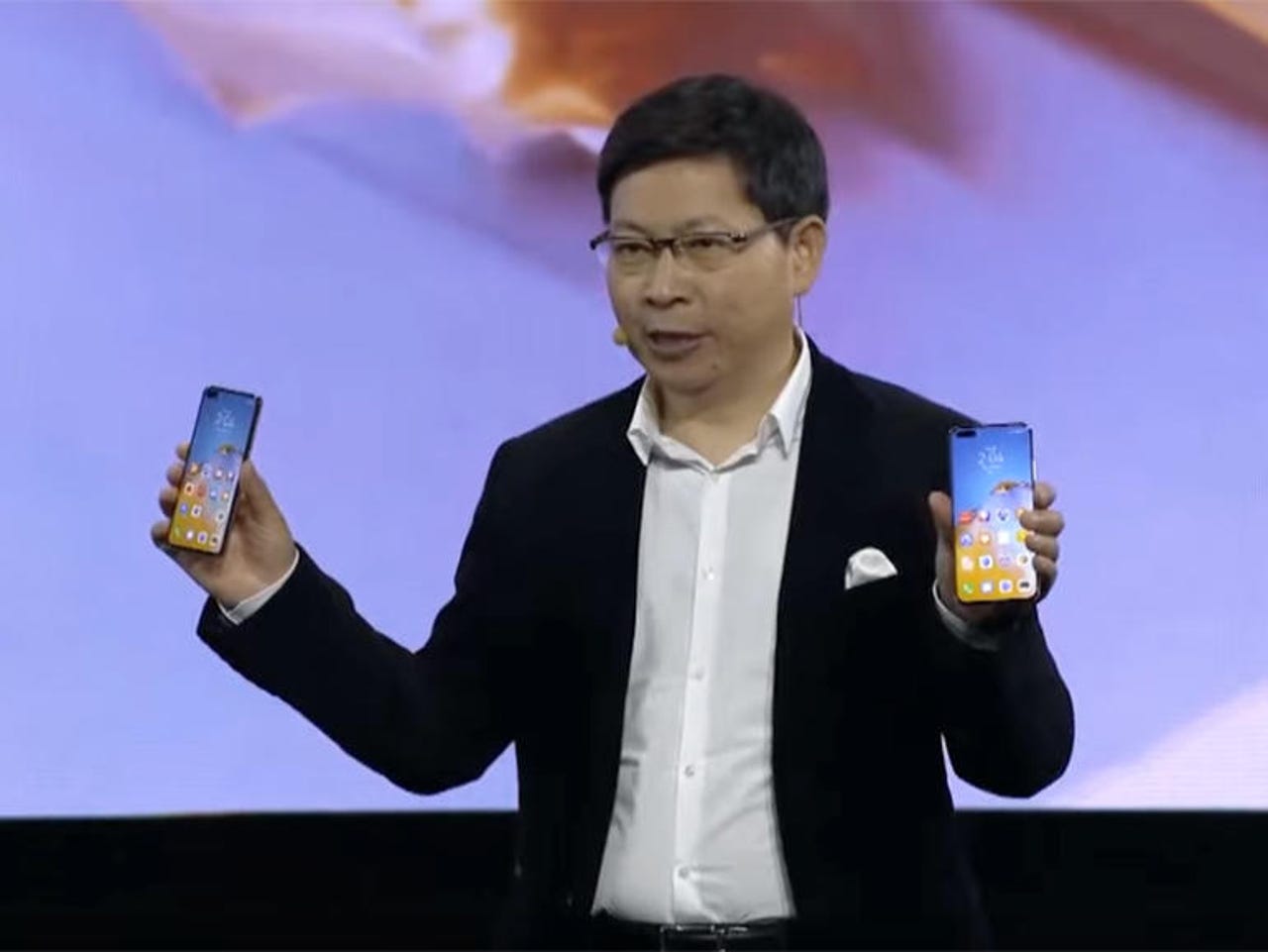Huawei's P40 Pro+ smartphone is a 'camera-monster'. But without Google apps, can it break through?


Richard Yu, CEO of Huawei's Consumer Business Group, announcing the P40 series.
Buying a new cutting-edge smartphone may not be high on many peoples' lists of priorities at this time -- especially one lacking access to Google's Mobile Services, including YouTube, Maps and the Play Store. Still, if you're in the market for a new handset, Huawei has announced its new P40 series (via a live-streamed YouTube event), comprising the €799 P40, €999 P40 Pro and €1,399 P40 Pro+.
The new phones, which highlight Huawei's leading-edge photography and video technologies, will be available in selected markets from 7 April (P40 and P40 Pro) and June (P40 Pro+).
Industrial design-wise, the P40 Pro and Pro+ have displays that curve into the back on all four sides -- something Huawei calls the Quad-Curve Overflow Display. This results in an almost bezel-free screen (91.6% screen-to-body ratio). Huawei also claims that the in-screen fingerprint reader is enhanced to deliver 30% faster authentication.
While the P40 and P40 Pro have glass backs in various colours and finishes, the flagship P40 Pro+ has a 'nano-tech' ceramic back -- in white or black -- that Huawei claims is particularly scratch-resistant and durable.
The displays are all Flex OLED panels -- 6.58 inches for the P40 Pro and Pro+ (2640x1200px, 441ppi) and 6.1 inches for the P40 (2340x1080px, 422ppi) -- with DCI-P3 HDR support and a 90Hz refresh rate. The 6.58-inch models have an IP68 rating for dust and water resistance, while the 6.1-inch P40 only manages IP53.
The cameras are the main focus of Huawei's P series phones, and the P40 series raises the bar over last year's excellent quad-camera P30 Pro, which majored on zoom and low-light performance. The new flagship P40 Pro+ has no fewer than five Leica-branded cameras: 50MP wide angle, 40MP ultra-wide angle, 8MP Periscope zoom (10x optical), 8MP zoom (3x optical) and a time-of-flight (ToF) depth sensor. Maximum digital zoom on the P40 Pro+ goes up to a massive 100x.
In his YouTube presentation, Huawei's consumer chief Richard Yu described the P40 Pro+ as "a really amazing camera ...a camera monster".
The P40 Pro has a quad-camera array: 50MP wide, 40MP ultra-wide, 12MP Periscope zoom (5x optical) and ToF. Propping up the range is the triple-camera P40, which has the standard 50MP wide-angle camera, plus 16MP ultra-wide and 8MP 3x optical zoom cameras.
The 50MP wide angle camera used across the P40 range is equipped with an extra-large 1/1.28-inch RYYB Ultra Vision Sensor that, Huawei claims, takes in 200% more light than the sensor in Apple's iPhone 11 Pro Max. Large (2.44μm) pixels and full-pixel octa-PC autofocus enhance low-light performance, while Huawei's XD Fusion Engine integrates the data from the multi-camera arrays to optimise the resulting images.
SEE: IT pro's guide to the evolution and impact of 5G technology (free PDF)
New AI photography features include Golden Snap, which combines scene recognition, facial feature analysis and posture detection to isolate the 'best moment' in a moving image. Other Golden Snap capabilities are AI Remove Reflection and AI Remove Passerby that respectively eliminate glare and unwanted subjects from an image.
The P40 series phones are based on Huawei's Kirin 990 5G chipset with 8GB of RAM on the P40 Pro+ and Pro, and 6GB or 8GB on the P40. Internal storage options are 256GB or 512GB on the P40 Pro+, 128GB, 256GB or 512GB on the P40 Pro, and 128GB or 256GB on the P40. All three models support Huawei's proprietary Nano Memory (NM) cards for external storage expansion.
The 226g P40 Pro+ and 209g Pro are powered by a 4,200mAh battery, while the 175g P40 has a 3,800mAh battery. Fast charging is available on all three phones (40W, 22.5W on P40), with wireless and wireless reverse charging on the Pro+ (40W/27W) and Pro (27W/27W).
For all the innovation, the lack of Google's apps and services – because of an ongoing US trade ban – will make it harder to persuade consumers to buy the phones, outside of China.
"Since Google's announcement to restrict Huawei's Android integration, Huawei's sales share performance in EU5 consistently declined each quarter from Q219 to Q419," said Jennifer Chan, Global Insight Director for Technology at analyst firm Kantar. "Huawei's P30 series was the first of its smartphones to be impacted by the restrictions and sales did not reach the same shares as the P20 series, in the comparative launch periods last year."
"Although camera quality remains the second highest feature-specific reason for buying a smartphone, this was the number one reason among Huawei's P30 owners with 80% of owners agreeing," Chan said. "There is no doubt that Google cutting off Huawei's Android license will continue impact Huawei's future sales in EU5, including the P40 launch: intention to buy a Huawei handset among smartphone owners looking to replace their phone in the next 6 months from January 2020 declined YoY from 19% to 17%."
"There is also a global movement of consumers buying cheaper smartphones, with brands such as Xiaomi gaining sales share, and in light of COVID-19 affecting consumer spending it is likely that this trend will continue," said Chan.